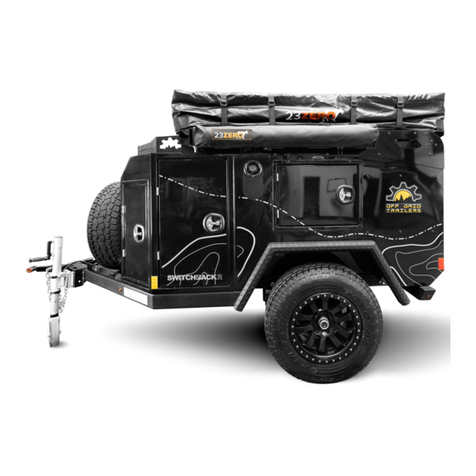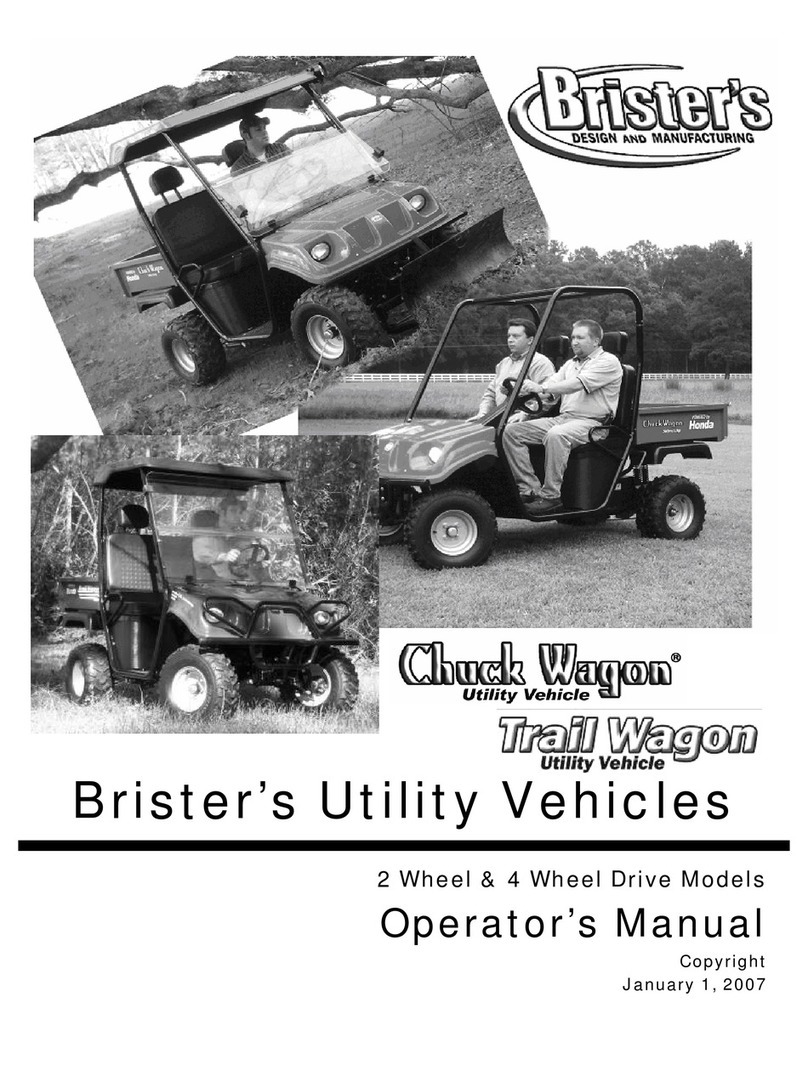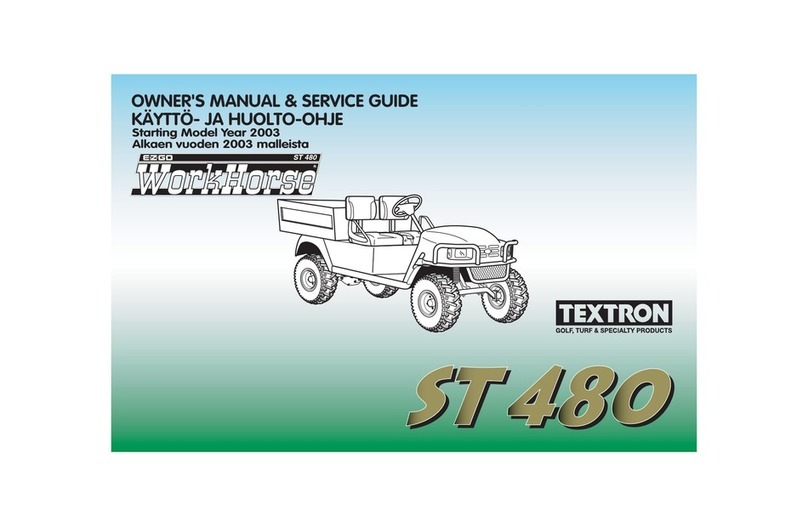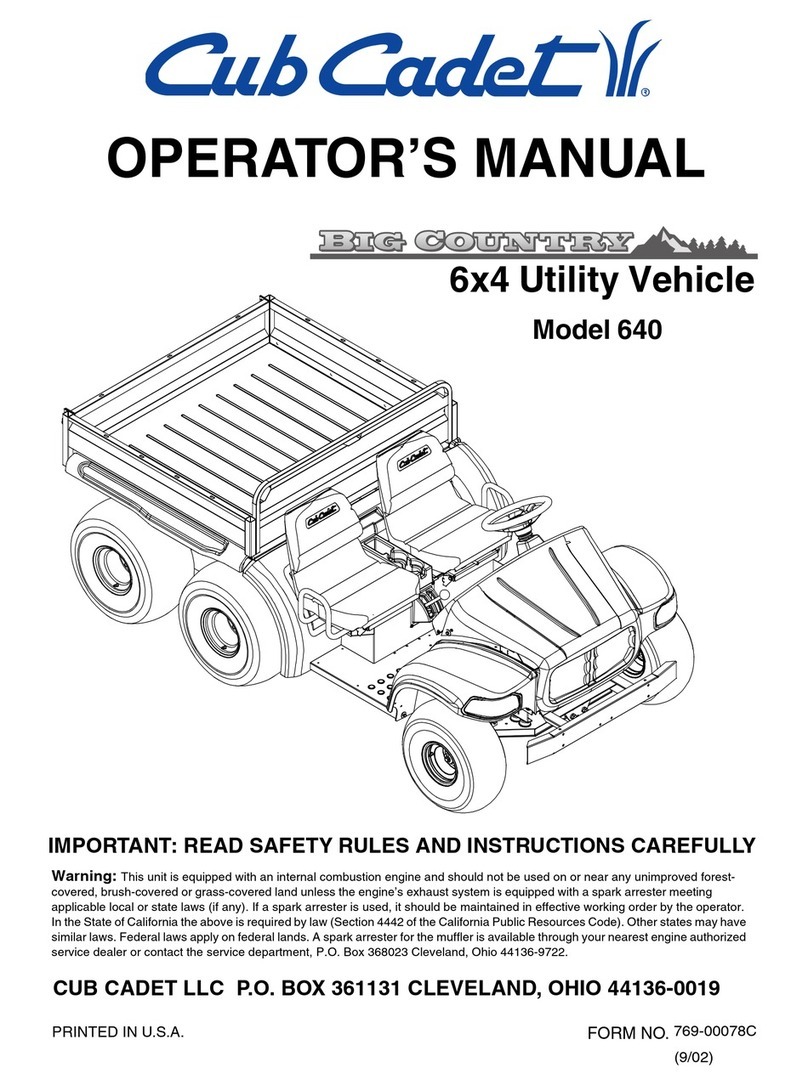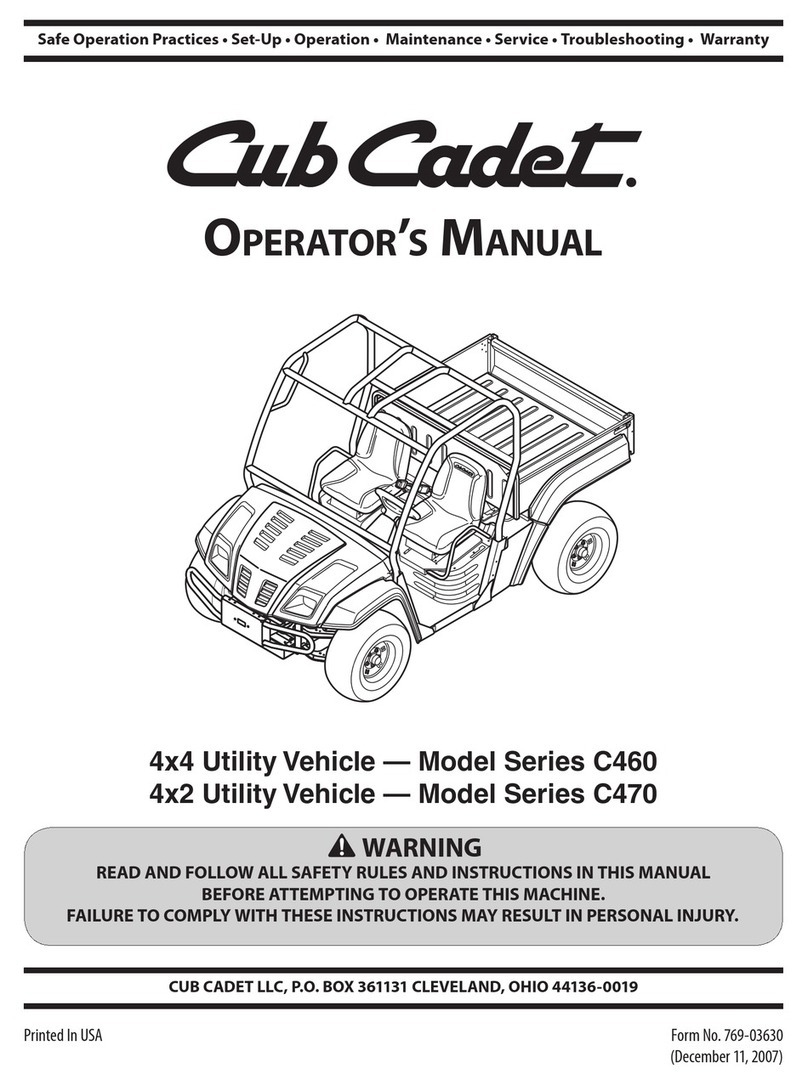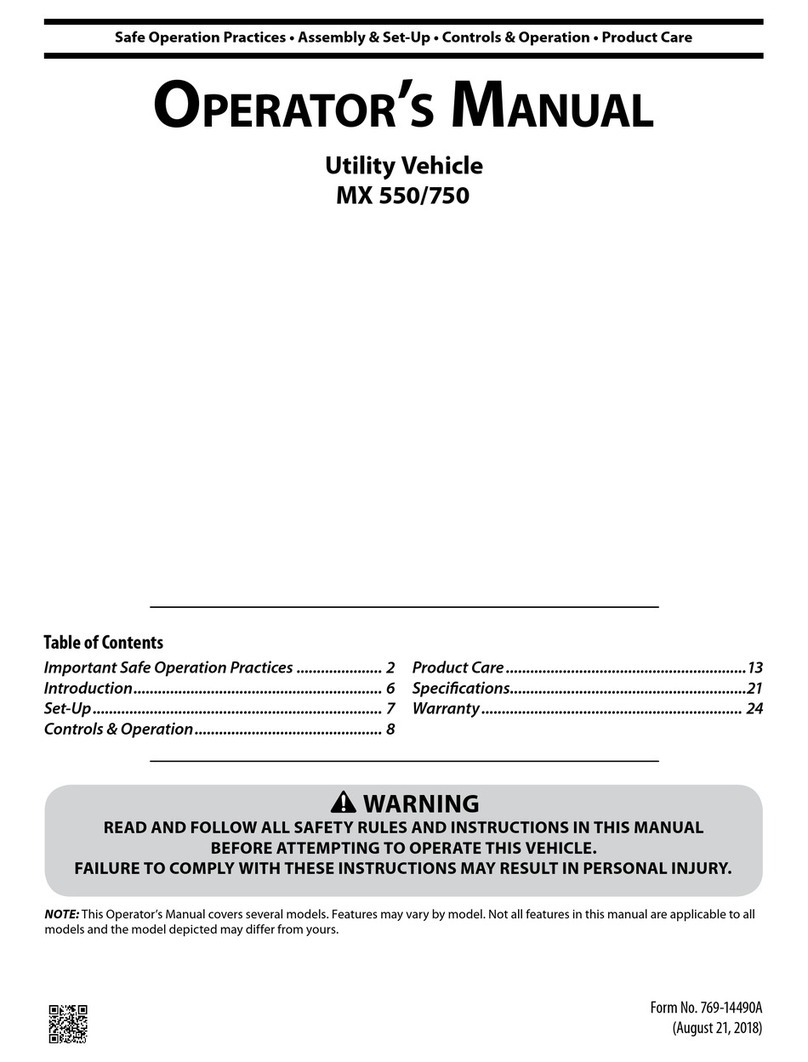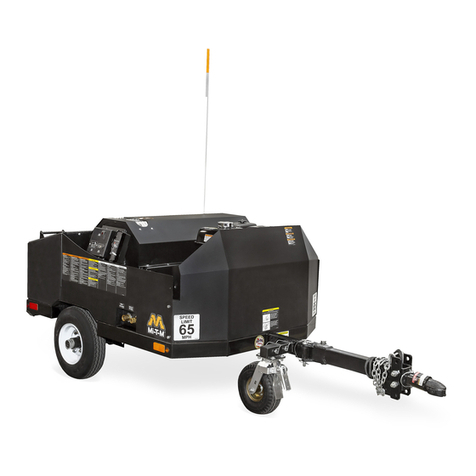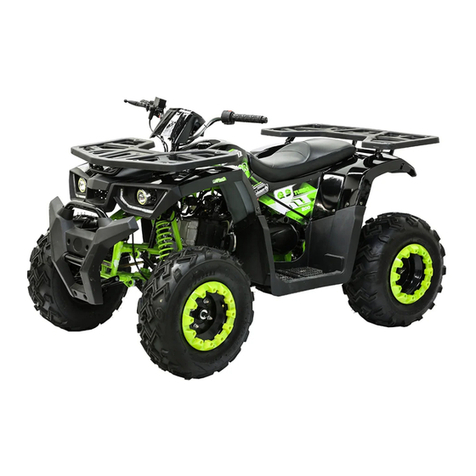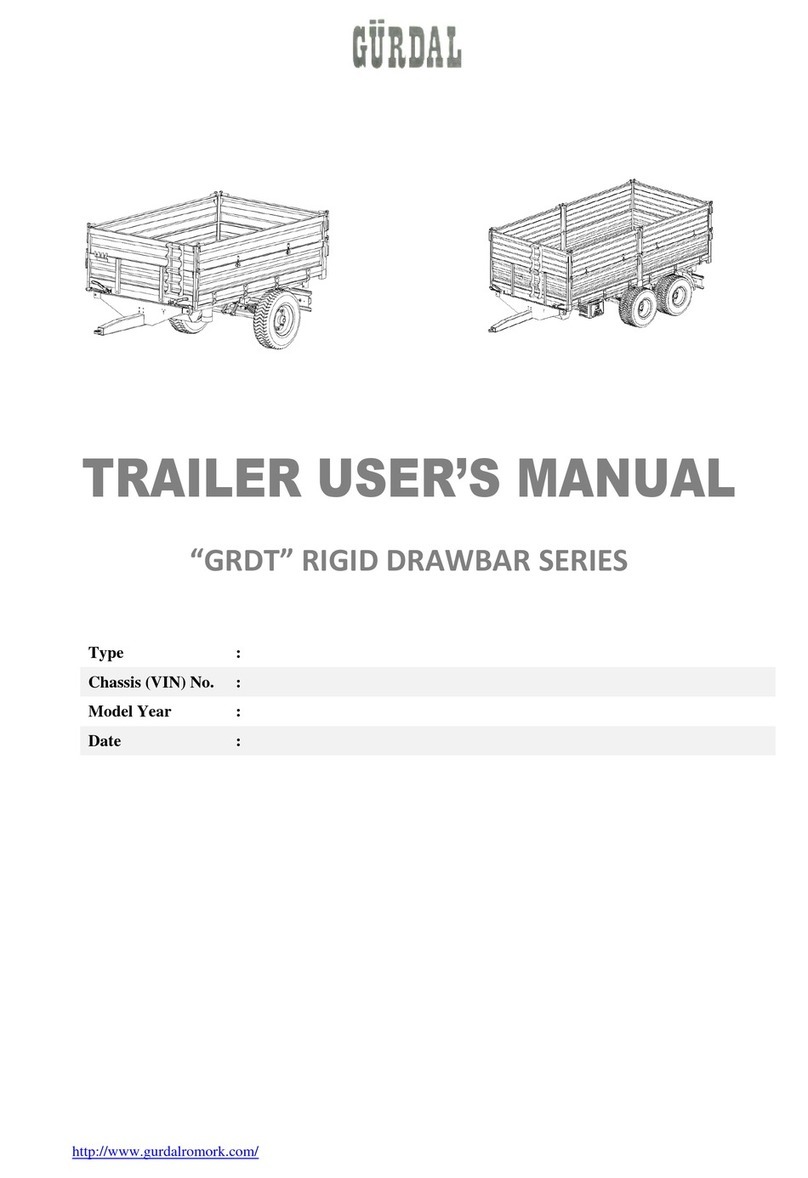LOADMASTER LEGACY 3 Series Operating instructions

LEGACY 3 SERIES
MAINTENANCE & REPAIR MANUAL
GENERAL “BODY” &
HYDRAULICS
LOADMASTER
100 W ELEVENTH AVENUE
PO BOX 186
NORWAY, MICHIGAN 49870
PHONE 906-563-9226
TOLL FREE 800-433-2768
FAX 906-563-9800
EMAIL loadmaster@loadmaster.org
RELEASE APRIL 2006
This is Manual p/n 7700003

TABLE OF CONTENTS Legacy “3”
Maintenance & Repair…general
“body” and “Hydraulics”
Hydraulics Manual…w/ Hydraulics
Repair
Schematics…Hydraulics & Electrical
Nomenclature “LoadMaster lingo
Pgs a & b
Section 01 Hydraulics…”how the system works”
Sec01-pg01 thru sec01-pg08
Section 02 Hydraulics…Checking & Adjusting
the various Hydrau settings
Sec02-pg01 thru sec02-pg08
Section 03 Trouble shooting…
Sec 03-pg01 thru sec03-pg04
Section 04 Repairs (various)
Sec 04-pg01 thru sec04-pg08
Section 05 Schematics…
Hydraulics
Sec05-pg01 thru sec05-pg04
Section 06 Schematics…
Electricals
Sec 06-pg01 thru sec06-pg04

April 2006
This is the Maintenance/ Repair manual for the
Legacy 3.
It includes general body Maintenance & Repair
AND is the Hydraulics Manual as well.
The information contained in this Manual
applies ONLY to the LEGACY3.
See other manuals for other LOADMASTER
products.
For the Legacy Product…
There are 3 manuals for a complete set:
1- the OPERATOR’S MANUAL with Preventive
Maintenance Manual…which also includes
some schematics.
2- The Parts Manual
3- This Maintenance & Repair Manual
Which includes the Hydraulics

800-433-2768
LEGACY3 {page date 04-12-06}
NOMENCLATURE…the “words” Loadmaster uses…use this lingo to “talk”
V20 “WorkSection”
(spooled sections)
The
Hopper
Throttle-Advance Limit
Switch
Push-pull Rod
Upper
LightPod
The “Tailgate-Mounted Valve”
The body’s Face
Ejector Blade
Undersill
“light bar
Sweep
Blade
Hopper
Sill
The “Body-Mounted Valve”
Riding step
hopper’s
Chute
Tailgate lift cylinders
Tellescopic
Cylinder
Slider
Blade
The “Chassis”
The “tailgate”
The “body”
Ejector Blade
Main Wrist Pivot
Sweep Cylinder
Cylinder’s
Rod
Slider
Cylinder
Slider
Shoes

800-433-2768
LEGACY3 {page date 04-12-06}
NOMENCLATURE…the “words” Loadmaster uses…best lingo to communicate with LOADMASTER people
MudFlaps
3
1
Gate’s “hinge”
Ladder rung
Gate’s
Turnbuckles
Gate Ajar Switch
Knobbed Lever
Tailside-Control
“Shafts/Tubes”
Access Door
“Decals”
Gate Ajar Light
“Body-Mount”
“Button
Switches”
Rocker Switches
In-cab “Rocker Panel”

Section 01
HOW IT WORKS..THE HYDRAULICS
This section of the manual is an overview of the various
individual hydraulic components and how they all work
together as a “system”. Reading this section will have
value to you because it will increase your overall
understanding of “how your LEGACY3 works”, which will
increase your problem solving skills and speed up any
troubleshooting.
The components…
Most LEGACY3’s are equipped
with a OMFB
PTO
. The LEGACY
pump
direct-couples to
the OMFB PTO; no prop shafting is used. When the PTO
is engaged on, the Pump will begin to rotate. A “PTO
engaged” dash-mounted pilot-lite will illuminate. The
PTO typically has a drive
ratio
of about 1:1.3. This
means if the Diesel is rotating at 1000 RPM, the pump
itself will be rotating at 1,300 RPM. The LEGACY3 pump
is typically a OMFB bent-axis, fixed displacement piston
pump. This is a “truck equipment” piston-pump that
handles higher speeds and pressures well. Since it is a
“fixed” displacement pump, any time the pump is
rotating it will create flow in proportion to its rotational
speed (RPM). The LEGACY uses a 4.4 cubic inch per
revolution pump. The circuit therefore is about a 33
GPM flow at a
diesel
speed of 1400 RPM.
The
body-mounted valve
is a 2-spool GRESEN V20. The
lowermost cover is the
inlet cover.
The inlet cover is
closest to the pump and directly connects to the pump
by the
pump pressure hose.
The inlet cover holds the
main relief
and has a
gauge stem
from which all of your
pressure gauge readings will be recorded. The LEGACY’S
main relief setting is *3150 PSI +/- 50 PSI @ throttle
advanced. The inlet cover also connects the
auxiliary
return hose
to tank. This auxiliary return provides a path
to tank for the body-mtd valve’s functions, since the
outlet of the body-mtd valve has a
power beyond sleeve
that allows pressurized fluid to be available downstream
to the tailgate-mounted valve.
The first spool section is the
tailgate section,
which is a
double-acting spool in the case of the LEGACY3’S with
optional
AutoLoks or single-acting when unit has the
standard “turnbuckle” gate latches. This work section
has no port devices installed (such as a port relief).
The second spool section (highest from body floor) is
the
ejector section
which is double acting. The ejector
telescopic
cylinder’s
extend (base-side) workport cavity
holds the ejector-controller called the “RESISTANCE-
CARTRIDGE”
.
This resistance-cartridge relief is the
hydraulic device the creates the necessary ejector
resistance on the route to “densify” the garbage.
Resistance cartridge has a adjustable stem. Turning
adjuster inward (cw) increases/“stiffens” the ejector’s
resistance as the operator packs (densifies) garbage
against the ejector’s face. Turning the adjuster outward
(ccw) decreases ejector resistance.
The resistance cartridge is typically set to 1250psi and
has a integral .062 orifice. When the resistance
cartridge trips open (allowing the ejector blade to
“creep” forward towards the cab), this orifice
meters
the
ejector-tellescopic release of oil to tank to “smallish”
amounts.[sec01-pg01]

When “on the route” and collecting garbage…the ejector’s
spool will always be in the centered-neutral position and
therefore the workports are “blocked”.
The resistance-cartridge
senses
both (a) workport pressure
(ejector-telly “extend” pressure) and (b) hopper blades packing
pressure. The worksection’s casting is internally passaged to
allow this to occur. Typically,
early in the day
, the hopper
blade’s pressures are relatively low because you are working
against the
smallest stage
of the telescopic cylinder. Therefore
hopper blade pressures are “too low” to trip open the
Resistance-Cartridge. Now the “workport” pressure “mode”
dominates…the Resistance-Cartridge will open and release to
tank a small amount of oil to tank…the ejector/telly will “move”
towards the cab
automatically
.
The telly/ejector
automatically
“moves/drifts” towards cab until
the 2nd (or 3rd) “bigger” stages of tellescopic “come into-play”.
Now
the hopper blade’s pressures are
routinely higher
and the
resistance-cartridge will trip open (releasing the telly/ejector)
when the blade pressures reach 1500 psi. The Parker
resistance cartridge has a “ratio” built-into the scheme…The
ratio Loadmaster employs is .85. <1250 setting divided by .85
equals 1500 psi> When the hopper blade pressure sensing
“mode” is dominating….the trip point is still 1250 PSI, but it
takes 1500psi “blades” pressure, or above, to trip open the
Resistance-Cartridge and allow the telly extend oil to meter
across the orifce to tank.
The final section of the body-mounted valve is the
outlet
cover.
The
power beyond sleeve
is mounted into the
outlet cover
of the body-mounted valve. The
PB sleeve
allows for feeding of pressurized fluid
downstream…through the
roof tubing
and to the
tailgate-mounted valve.
The
tailgate-mounted valve
controls the blade actions and
most of the optional equipment, such as a roof mounted
“reever” or the “kick bar”. It is a GRESEN V20 valve that
usually has 3 or more working sections and hangs from the
tailgate’s roof. (The sections with the “spools” are called “
work
sections”.)
The first section of the tailgate-mounted valve is the
inlet
cover.
This inlet receives the flow from the roof mounted
pressure tube. It also is the origin of the
return line
since the
cover on the other side is a plugged
turnaround outlet cover.
The next “upstream” sections are the option
work
sections
such as the “2-10 reever” and the “kickbar”. Option work
sections have “spools” which are spring centered and are
manually shifted in or out to direct flow to a desired function.
Typically there maybe “pressure-limiting port mounted reliefs”
or speed- controlling workport orifices used for options on the
LEGACY3 (see chart near end of this “how it works” writeup.
These GRESEN V20 option sections must have an internally
casted flow path that is known as “parallel” construction. (see
parts manual for correctly ordering any valve “sections”).
The hopper-blade section closest to the pump is the
sweep
blade work section
, and it always comes next, (which is
“upstream” of the slider blade work section). This spooled
section has a
knockout positioner.
This knockout postioner is a
device that is controlled by one pressure “’trip” setting for
both directions of spool shift. When the spool is
manually shifted, the KO mechanically holds the spool
shifted until the next time the pressure
rises
to its
setting, whereupon it releases the spool and the spool
knocks-out to centered-neutral position. This pressure
rise typically occurs when the cylinders “bottom-out”.
This sweep section has a port relief mounted to the
sweep cylinders
base-side, known as the
secondary port
relief.
This secondary port relief can allow the sweep
blade to “unwrap” a little if the pressure induced should
exceed “critical” structural loads. This protects the
structure from excessively high loads that could
otherwise cause structural damage or componentry
damage (never shim or deviate from Legacy3
specification of 3700 psi
crack
).
Opposite the
secondary port relief
(at the opposite work
port) is an
anticavitation check
that allows some
“makeup oil” to go into sweep’s rod-side during this
slight blade unwrap. Whenever the secondary port relief
is actually relieving, this anticavitation check precludes
powerful suction effects that could extrude the sweep
cylinder’s piston seals.
The last working section (the one with the
throttle
advance switch
trigger) is the
slider blade section.
This
slider blade section has no port mounted devices. The
slider section also has a
knockout positioner
directly
coupled to one end of its spool.
The two hopper blade work sections have an internal flow path
known as “tandem center”. When a V20
tandem center
spool
section is shifted to do a function, it blocks the valve’s power
core on the
upstream side.
This characteristic is important in
terms of proper blade
sequence.
Since the start of the first half
and second half of the semi-automatic blade cycle is the
“simultaneous” shifting of
both
blade spools, the
sweep blade
will always move first since its spool is
tandem center
and it is
upstream
(closest to pump)
of the slide blade spool.
The last section of the tailgate-mounted valve is the
outlet
cover.
In the case of the LEGACY, this cover’s outlet port is
actually plugged but this section is casted to be a
turnaround
cover. The actual return hose is then connected to an outlet
port of the
inlet cover
.
Leaving the tailgate-mounted valve, the oil flows through the
roof return tube
to the
return filter.
The “tank-top style”return filter is a 5-micron (nominal) with a
integral bypass valve. It is has a high-preformance Microglas
element and a
condition
indicator
affixed to the head casting.
The
hydraulic reservoir
if fully dressed with a
level gauge with
thermometer, magnet type drain plug, filler/media breather,
and
cleanout cover.
The suction side of the tank has a
submerged 100 mesh replaceable
suction filter.
It has a 3-PSI
bypass valve built into it. The tank has a baffle that separates
the suction side from the return side to promote settling of dirt
and entrained air.
[sec01-pg02]

The open loop…
When no functions are being performed (all
valve spools in their centered, neutral position); the oil flow
follows a path known as the “open loop”. It originates at the
oil tank’s
suction line filter
, through the
suction hose
, to the
pump
, through the pump
pressure hose
, to the
body-mounted
valve
, up the
roof tube pressure
, to the
tailgate-mounted
valve
, back through the
roof return tube
, through the
return
line filter
and back at the
tank
again. As long as none of the
spools are shifted, the oil will flow in this simple open loop.
The tailgate up/down function…
The LEGACY3’s tailgate is
power-up and power-down (known as “double-acting”) if built
with
optional
AutoLoks. The last bit of the tailgate cylinder’s
stroke will operate the automatic lock feature. The lowermost
spool section of the body-mounted valve is the “tailgate”
section and is plumbed to the tailgate lift cylinders.
When the hand lever is pulled
outward
the spool itself also
moves outward and the pump’s output flow is connected to
the gate cylinders “up” port (which is the “base-end” cylinder
port). At this very same moment, the same spool will also
connect the “rod-side” ports to tank. So the gate will “raise”.
Beginning FEB01, 2005…all Legacy3 production began using
Parker’s Resistance-Cartridge “style” of ejector controller.
The Resistance-Cartridge ejector-controller is the device that
allows the ejector to automatically “drift” forward (towards the
“cab”) during route collection. The Resistance-Cartridge style
of ejector-controller does NOT use a ¼” pilot hose connected
to the tailgate UP workport. If your unit has the ¼” pilot hose
(pre FEB2005)…the unit has the obsolete HI/LO style of ejector
controller not covered by “this” manual. See earlier Editions of
this manual for discussion of the obsolete HI/LO controller.
If the hand lever labeled tailgate is pushed
inward
, the pump
will connect to the gate cylinder’s “lower” port (and the ‘base-
end” ports will connect to tank), and the gate will
lower
under
pressure (powered down).
If the Legacy3 has the
standard
turnbuckles for tailgate
latching, the tailgate worksection is single acting (power up
and gravity down). The port closest to handle will be plugged
and the worksection casting/spool will be “3-way” scheme.
Since the tailgate raise/lower spool section has no
port
relief at
all, its
only
pressure-limiting device is the main relief of the
body-mounted valve. This fact makes gate up/down
worksection useful for
checking/setting
the Main System Relief
(see contents for this writeup).
The tailgate cylinders have orifice restrictors built into each
port (at the cylinder itself). This purposeful restriction
precludes the tailgate from “over-running” the pump flow
when lowering the gate, allowing the gate to lower smoothly.
Never stand or cross underneath a raised tailgate.
Tailgate may unexpectedly and suddenly fall causing
serious injury or death.
The auxiliary return hose provides the return path to tank
during tailgate raising or lowering (needed since the Body-
Mounted valve has a “power beyond sleeve”).
The ejector function…
The
telescopic cylinder
actuates the
ejector blade. The uppermost work section of the Body-
Mounted valve controls the ejector’s telescopic. When the
telescopic is fully
extended,
the ejector blade is fully rearward,
towards the tailgate. The ejector blade does two jobs. When
the tailgate is fully raised at the landfill or transfer station, the
ejector blade is used to “push-out” the payload.
[sec01-pg03]

When the LEGACY3 is “on-the-route”(tailgate fully lowered
and latched
, of course), the ejector blade begins parked at
rear of body and then slowly, automatically drifts forward
(towards cab) as the garbage is collected and the payload
builds. This
drift
will occur automatically as a “pressure head”
is continuously maintained at the
extend
side of the telescopic
by the Parker Resistance-cartridge.This second “on-the-
route”job of the ejector is to provide a resisting, yet
“automatically” drifting, front surface for the hopper blades to
compress/densify garbage against. This resistance is created
by hydraulic pressure on the base-side (extend port) of
telescopic as the telescopic
retracts
toward the cab (blade
drifts forward towards the cab).
The Resistance-Cartridge style of ejector-controller:
Has no external pluming (no external pilot hose) and is
“adjustable” (cw/in “raises” trip-open setting and ccw/out
“lowers”)
Has a “orifice” built into it that restricts/meters the oil release
whenever Resistance-cartridge trips “open”
Is set to 1200psi “trip”…opens telly extend to “tank” when it
senses pressure “rises” above the 1200 psi trip setting
Senses “both” telly extend (workport) pressure and
the hopper’s blade (pack) pressures.
Early in the day…the workport pressure
mode
“dominates”.
Later in the day…the Hopper Blades pressure-rises
mode
will
dominate and ‘trip open” the Resistance Cartridge.
The compact blades function…
Two of the
Tailgate-
Mounted valve’s
working sections controls the two hopper’s
compaction blades. The blade that pivots (rotates) is called the
sweep blade.
The blade that slides in the track channels is the
slide blade.
If the Tailgate-Mounted valve has more than two
working sections (the sections that have moveable “spools”),
the extra work sections are for the “optional equipment”. Work
sections for the “options” are always “in front” (upstream;
closest to the pump) of the blades work sections.
The sweep blade’s work section is always upstream of the
slider blade’s work section. These two blade sections (and only
these two) have a casted flow path known as
tandem center.
A
tandem center work section has the “power core” internally
blocked
upstream
…this means that the shifted spool
closet to the pump
(the upstream sweep section) will
consume
all
of the available pump flow with any
downstream spools that are also shifted (the slider
spool) getting no flow until the upstream section (the
sweep)
shifts back to neutral.
This creates a simple (yet important) function “sequencing”
effect. Since the correct operator’s method of cycling the
blades is to shift and release
both
spools’ hand levers
simultaneously, the sweep blade rotates (sweeps)
first
while
the slide blade sits motionless waiting for the sweep’s spool to
knock-out to neutral. At the very moment the sweep’s spool
automatically shifts to neutral, all of the pump’s flow is then
directed to the slider blade’s cylinders and the slider blade
begins to move. This is correct/necessary sequence of
functions.
As mentioned earlier, both the sweep and the slider work
sections have knock-out (aka…”kickout”) positioners. These
knockouts, when teamed with the plumbing scheme and the
“tandem” center section castings/spool cuts, provide for the
sequencing
of the semi-automatic cycling of the compaction
blades. The blades must
both
sequence in their specific order
and they must move distinct and separate of each other to be
functioning normally.
The
knockout-positioner
is the device that holds the blade
spools shifted until the hydraulic pressure in that particular
section
rises
to the knockouts
pressure setting.
When this
setting is reached, the spool is released and it shifts to neutral
(spool centered) position. The pressure setting specification for
the LEGACY3 is…
sweep
knockout spec is 2250 PSI @ throttle
advanced (8-12-04) and the
slider
knockout spec is 2950 PSI
@ throttle advanced. The pressure
rise
typically occurs when
the pair of cylinders bottom-out at the end of their stroke.
Having said all of this, the compact blades do a semi-
automatic compaction cycle as follows…The cycle begins
with both spools (via hand levers linkage controls)
manually simultaneously shifted outward and released.
Both knockout positioners grab and hold the spools
shifted. The
sweep
cylinders begin to move first with all
of the pump’s flow going to the sweep cylinders. (The
sweep’s valve section is closest to the pump and its
internal casted passages are “tandem-center”, which
means all of the pump oil goes to its own workport and
nothing goes downstream.) The sweep blade continues
to rotate until its cylinders complete their stroke and
they bottom-out. This bottoming-out causes a rapid rise
in sweep pressure and the sweep knockout will knockout
the sweep spool to
neutral
centered
.
Meanwhile, the
slider spool has been held shifted with no pump flow
available to it. At the very moment the sweep spool
knocks-out to neutral, all the pump flow is now available
to the slider spool which begins directing the flow to the
slider cylinders. The slider blade
now
begins to move
and it continues to move until its cylinders bottom-out
and the pressure rises to its setting. The slider knockout
[sec01-pg04]
Resistance
Cartridge

then knocks the spool to centered neutral and the first
half
of the semi-automatic blade
cycle
is complete.
Both
spools are now at their centered neutral position. The
blades are said to be stopped at their cycle
interrupted
position. This is correct and normal functioning.
The second half of the semi-automatic cycle begins
(after the operator visually assures it is safe to do so)
with both hand control levers being pushed inward
simultaneously. The sweep blade again moves first (its
valve section is still upstream of slider, of course) and
the second half of the cycle occurs the same way but in
the opposite direction of the first half.
The secondary port relief SYSTEM…
As mentioned
earlier, the sweep work section has a
port relief
on the
sweep cylinders extend-side (cylinder’s base-end) and
an
anti-cavitation check
opposite of it (on the retract-
side; the rod-side). Acting together, these two port
mounted cartridges are a
system
that can relieve the
portion of the structural loads that are above allowable
amounts. (This would be seen as a slight
unwrapping
of
the sweep blade when the slider blade is nearly all the
way up). In some applications this situation will rarely
occur and in others it may sometimes occur when the
LEGACY3 body is near its full capacity.
The sweep’s secondary port relief is set to *3700 PSI @
“crack”. (Crack being 2 GPM). This particular relief must
use VITON seal for performance reasons.
When the slider blade is traveling upward (“compacting”
the garbage), the sweep blade has already been fully
rotated down to “capture” the hopper’s garbage and the
sweep worksection will be in its centered neutral
position. The compacting action of the slider blade
traveling upward will necessarily
induce
a hydraulic
pressure on the sweep cylinders base-side. The
only
relief located to relieve the excessive
portion
of this
induced load is the relief on the cylinder
ports
side…the
secondary port relief. (This is because the sweep spool
is in its centered neutral position and the spool itself
blocks
any inlet cover mounted relief from “seeing” the
induced pressure on the work port side).
The anti-cavitation check simply (yet importantly) allows
for oil to be drawn into the sweep cylinder rod-side
during
any port relieving that may occur. This prevents
any powerful
suction
effect from damaging cylinder
seals.
This secondary port relief
SYSTEM
prevents expensive
component and structural failures by preventing blade
loads and pressures from exceeding allowable values.
LOADMASTER uses a fixed, non-adjustable secondary
port relief that is set to the
correct
value for the
LEGACY. Do not shim adjust any of LOADMASTER’s
non-adjustable reliefs.
The optional equipment
… Most LEGACY3’S will have
an optional attachment or two. The option work-sections
are in the tailgate-mounted valve just
up
stream of the
hopper blades worksections. Since upstream, they get
flow “priority”…hopper blades will “stall” when using one
of the option worksections (desired). [sec01-pg05]

These
option
work sections are simple manually shifted
spools that must be held shifted for their function to
occur. They are spring-centered to neutral and correctly
return to center-neutral when the knobbed-hand lever is
released. The “kickbar option”, the “2-10 reever”, or a
spooling “ winch” may be typically installed “container-
handling” options. They are always double-acting and
the work sections may have port devices.
Legacy3 options
may have workport mounted
ORIFICES (speed control) and/or workport mounted
PORT RELIEF(S) (pressure control)
This chart applies to LEGACY3 (may2004/apr 2005):
Kart Dumpers style using Loadmaster’s “Extra
Worksection” (in tailgate-mounted valve)… extra
worksection plumbed to/dedicated to Cart Tippers…
Orifice…if fixed style there will be a 7/64” diameter
orifice at both work ports. Mostly you will find INLINE
adjustable restrictors plumbed into each workport hosing
(preferred newer style of orificing).
Port Reliefs…Up=1800 PSI crack
Down=700 PSI crack
[Note: “crack” means it is set at only 2 GPM…typically
add 200PSI at
full flow
]
Clearstep Rollbar (for small 1yard/2 yard containers)
Orifice…will be fixed orifices at both workports of
7/64” diameter.
Port Reliefs…Up=1800 PSI crack
Down=700 PSI crack
“2-10” Cable Reever (body roof mounted)
Orifice…none at all
Port Reliefs…none at all
“1-2” Sling Lift (for small 1yard/2 yard containers)
Orifice…fixed 7/64” diameter at both workports
Port Reliefs…Up=1800 PSI crack
Down= None
Spooling “Winch” (per ordered line-pull, 8k, 10k, 12k)
Orifice…None
Port Reliefs…UP=1800 PSI crack*
Down= none
*the winch model/motor/gearing “changes” per line-pull
ordered…but pressure “stays” at the UP=1800 PSI crack
Optional Regeneration
The Legacy 3 is available with
optional
regeneration.
The regeneration valve is patched into the slider blade’s
cylinder plumbing and it speeds up slider
downward
travel speed (
only
this direction). It greatly enhances
route productivity (Loadmaster has field-install kits
available if you wish to add it “later”…relatively EZ to
do…as long as your Legacy3 has 2 1/2” diameter
slider cylinder
rods
…regeneration does
not
work with
some early Legacy3’s that had the 2.0” diameter slider
cylinder rods).
See plumbing schematic below for how the regeneration
is plumbed up. It is effectively a “add-on” valve into
slider cylinders’ hosing.
For the Legacy3 (only)…your diesel’s throttle advance
will have been typically programmed for 1400RPM. This
programming is same
with or without
regeneration
(which is unlike Loadmaster’s EXCEL models…thrtl adv
programming value will change if EXCEL has
“regeneration”…see EXCEL’s manuals).
A typical Legacy3 will have a total hopper blades cycle
time of 23-24 seconds
without
regeneration (at a
typical pump flow for Legacy3 of 33 GPM).
A typical Legacy3
with
optional regeneration will have a
total cycle time for hopper blades’ of 19-20 seconds.
Note: This “cycle time” information is accurate only if
you have the OMFB piston pump/ OMFB pto
“combination”.
[Sec01-pg06]

OVERVIEW OF LEGACY3
SPECIFICATIONS… (may 2004)(feb2005)
This page lists the LEGACY3 specifications needed for
checking and setup. These values apply only to the
LEGACY3; other LOADMASTER models will have other
specifications. Refer to the manual that specifically
applies to that model. Always pay attention to the
diesel RPM specified…if you measure at some
other
diesel RPM, the reading will
not
be correct!
MAIN RELIEF…
This is located in the inlet cover of the Body-Mounted
valve. The body-mounted valve is the valve just inside
the body access door. Take your reading at the gauge
stem provided at the inlet cover of the body-mounted
valve.
Spec is 3175-3200PSI @throttle advanced
RESISTANCE-CARTRIDGE ejector-controller…
Spec is 1200 PSI
trip-open
at less than ½ gpm
measured
at the workport
.
The resistance cartridge has TWO
modes
to trip open
and release ejector/telly to “drift forward”.
Early in the day
…when the hopper blades are “packing
at relatively low pressures…the “work port” sensing
mode dominates and the Resistance-Cartridge will open
anytime the “work port” pressure is 1200psi or above.
(early in the day…means packing against the
“smaller diameter” stages of the ejector’s telly)
Later in the day
…when hopper blades pressure has
risen above 1400 psi….the sensed hopper blades
pressure will “open” the resistance cartridge. This 1400
psi is the 1200 psi divided by the resistance cartridge
“ratio of .85”.
(
later in the day
…means packing against the “bigger
diameter” stages of the ejector’s telly).
SWEEP KNOCK-OUT POSITIONER…Legacy3
This device is directly coupled to the sweep
worksection’s spool of the “tailgate-mounted valve”.
Spec is 2200-2250 PSI @ throttle advanced
See table of contents for “how to” check/adjust.
(08-12-04)
SLIDER KNOCK-OUT POSITIONER…Legacy3
This device is directly coupled to the slider worksection’s
spool of the “tailgate-mounted valve”.
Spec is *2950-3000 PSI @ throttle advanced
SECONDARY PORT RELIEF…
This cartridge type port relief is screwed into the sweep
worksection (on the cylinder’s base-end) of the tailgate-
mounted valve.
Spec is 3700 PSI @ “crack” flow
This setting is not adjustable (and do not “shim”).
For more detailed explanations of these specifications,
see the “check and setup” writeup that applies to each
particular specification.
THROTTLE ADVANCED RPM…
This is the
diesel
RPM that the diesel will raise to when
the LEGACY3’s electric controls signal the need to do so.
Spec is 1400 RPM-1450 RPM (typically for
Legacies
only
).
When the diesel speed does advance, it will be
noticeable to the ear and can be read at the cab’s
tachometer.
DIESEL IDLING RPM…
This is the diesel RPM with diesel at idle
Spec is per whatever the diesel manufacturer
says it is supposed to be; usually about 750 RPM.
EVERY SPECIFICATION IS TO BE MEASURED WITH THE
GAUGE COUPLED AT THE INLET COVER OF THE BODY
–MOUNTED VALVE!
If the readings are taken at some
other spot in the hydraulic circuit, the readings will be in
error.
LOADMASTER has installed the male gauge stem for
gauge coupling at the inlet cover of the body-mounted
valve as standard equipment.
LOADMASTER has available the 3000 PSI glycerin filled
gauge, 2 feet of hosing, and the matching female
coupler all preassembled. (Order LOADMASTER P/N
0130014).
This particular type of coupler requires that the pressure
be low to cleanly couple/uncouple. Shut down the
diesel and disengage the PTO when
coupling/uncoupling the gauge to avoid having hydraulic
oil escaping.
Follow all Safety Precautions outlined in this
Operator’s and Maintenance Manual when performing
any Checks or Adjusts.
[sec01-pg07]

OVERVIEW OF LEGACY3
COMPONENTRY… (may2004)
PTO… Usually a OMFB PTO that will allow the pump to
be direct coupled to the PTO. Drive ratio is typically near
1:1.3, which is to say a 30% speed increaser. The
specific part number will vary depending on the type of
chassis transmission, rotation required, etc.
PUMP…Usually a OMFB fixed-displacement piston pump
in a 4.4 cubic inch per revolution displacement. The
specific part number will vary depending on the
rotational direction needed
BODY-MOUNTED VALVE…A GRESEN V20 SERIES
configured to LOADMASTER’s specification. This valve
always has 2 spooled work sections. One worksection
controls the tailgate cylinders and the other worksection
controls the ejectors telescopic
TAILGATE-MOUNTED VALVE…A GRESEN V20 SERIES
configured to LOADMASTER’s specification. This valve has
usually has 3-4 work sections. Closet to the pump will be any
“option” worksection, followed by the sweep worksection, and
lastly the slider worksection. The sweep and the slider
worksections have devices called knockout positioners directly
coupled to their spools.
RETURN LINE FILTER… A Internorman 5 micron (nominal),
tank-top microglass element with integral bypass valve and a
filter condition indicator gauge.
OIL RESERVOIR…In-the-body 32 gallon capacity tank with
magnetic type drain plug, fill level gauge with thermometer,
top surface clean-out cover, combo screened filler/breather,
and a full port ball valve at suction line. Inside the tank, near
the bottom, is a 100 mesh suction line strainer. Optional
45gallon round frame mounted tank.
TELESCOPIC CYLINDER…The ejector blade is actuated by a
HYCO telescopic cylinder. It is built to a LOADMASTER
dimensional specification for to suit the LEGACY3. When the
telescopic is fully extended, the ejector blade is fully rearward,
towards the tailgate.
SWEEP CYLINDERS…A pair of rod-type hydraulic
cylinders. The LEGACY3 uses a 4-1/2” bore x 21-1/2”
stroke with a 2” rod diameter. These are internally
“retract” cushioned to reduce end of stroke pounding.
Premium quality design and manufacture by RAMROD.
All of the LEGACY3’s various cylinders have zero-leak o-
ring boss ports and feature chrome plated rodding.
SLIDER CYLINDERS… A pair of rod-type hydraulic
cylinders. The LEGACY3 uses a 4-1/2” bore x 32-1/2”
stroke with a 2 1/2” rod diameter. These are internally
“extend” cushioned (with cushion “bypass” check valve
in retract direction) to reduce end of stroke pounding.
Premium quality design and manufacture by RAMROD.
TAILGATE CYLINDERS… A pair of rod-type hydraulic
cylinders. The LEGACY3 uses a 3-1/2” bore x 30” stroke
with a 2” rod diameter for optional Autoloks. If the
Legacy3 has standard turnbuckles, a singleacting
cylinder 3-1/2” bore x 2-3/4’ rod x 29” stroke. Both of
these style cylinders have port-mounted orifices.
IN-CAB ROCKER SWITCH PANEL…The various
switched electrical circuits will have their “inside the cab”
switches grouped together here. A switch is “on”
(closed) if the orange color band is visible. This switch
panel is typically located just to the left of the steering
wheel. A PTO-engaged pilot lite will be dash mounted.
FUSE BLOCK…All of the various branch circuits
originate at this ATC style fuse block which is typically
located nearly under the dash in a protected location
near the operator’s left foot.
IN-CAB RELAYS…Some LEGACY3’s often require
relays to control the “throttle advance” or other
functions. The exact number of relays on any particular
LEGACY3 is dependent upon factors that include the
particular chassis used. LOADMASTER uses IDEC brand
quality relays. These relays are the yellowish,
transparent “ice cube” relays that are typically located in
a protected “inside-the-cab” spot usually somewhere
near the driver’s left foot.
FIREWALL TERM STRIP…Every LEGACY3 has a term
strip mounted to the firewall located “under the hood”
ahead of the driver’s side. The color-coded, labeled
wires “pass through” this strip. LOADMASTER includes
this as a “troubleshooting” feature to speed up finding
the source of an electrical circuit malfunction.
HARNESSES…The electrical wires are bundled, labeled,
colorized, and protectively covered in a “harness”. The
overall electrical harnessing is made up of several
independent
subharnesses
connected together at
strategic locations with premium quality DEUTSCH
metallic body multi-pin connectors.
LIMIT SWITCHES…The throttle advance limit switch
and the tailgate ajar switch is the same switch. The
throttle advance switch is wired N.0. (and closes
whenever the slider spool is shifted out of neutral) and
the tailgate ajar switch is wired N.C.(and is held open by
a lowered tailgate). This switch is a MICROSWITCH
brand wobble stick with sealed body. A cable connector
seals the cable as it enters the switch.
BUTTON SWITCHES…The “buzzer signal” and
“throttle” advance switches are fully encapsulated and
mounted to a stainless steel panel with a stainless
unpainted
grounding post. Has a “click” feel when it
switches. [sec01-pg08]

Section 02 Checks and Setups
CHECK and SETUP… BLADES
“CYCLE TIME”
“CYCLE TIME” IS THE TOTAL NUMBER OF SECONDS IT
TAKES THE SLIDE AND SWEEP BLADES TO COMPLETE
ONE PACK CYCLE, WHILE THE DIESEL IS AT ADVANCED
THROTTLE RPM.
The LEGACY3 specification is 24-25 seconds with
the diesel’s RPM advanced to 1400-1450 RPM
(without optional regeneration). The LEGACY3
spec is 19-20 seconds when optional
regeneration is installed.
One complete pack cycle is to start with both blades at
“home” position and end up also at “home” position.
Checking Procedure:
1- Both the slider and sweep blades are parked in
“home” position.
2- Diesel running; Transmission in neutral; Park Brake
is applied on; PTO is engaged on; Throttle Rocker
switch is on (red band will show)…
3- This is a two person task. One person with a stop
watch and one person manning the blade’s hand
control levers.
4- Pull both control levers outward simultaneously
(and release them) as stop watch is triggered on
spoken “go”.
5- The person manning the controls must be in a state
of ready to “push in” (and release) the hand control
levers at the very instant that both levers are seen
to kick-out to neutral. (This is the “interrupted” or
half-way point of the automatic cycle.) This
interruption must be kept as brief as practical to
correctly measure the “cycle time”. Meanwhile, the
stop watch has continued to run.
6- Now the stop-watch holding person must be alert to
stop the watch at the exact moment the blades are
both back to home position (both hand levers will
have “kicked-out” to neutral).
7- Record this number of seconds and repeat the time
measuring process a total of three times for best
confidence of accurate measurement.
STAY CLEAR OF MOVING HOPPER BLADES AND THE HOPPER
LOADING SILL WHEN BLADES ARE MOVING! IF YOU OR A
WORK PARTNER IS CAUGHT IN THE BLADE ACTION, SERIOUS
INJURY OR DEATH WILL RESULT.
To adjust the cycle time, alter the diesel’s throttle
advanced RPM setting.
Do not adjust outside the
previously specified range….damage to componentry
may occur.
Most diesel’s today are “E-DIESELS”. You will most likely
need to schedule a visit to your local chassis dealer since
the
advanced throttle RPM
is a programmed setting and
will require a programming device that you will most
likely not posses.
If your chassis is not a “E-DIESEL”, it probably will have
a LOADMASTER installed air powered throttle advance
system which you can adjust yourself.
If you do adjust the diesel’s advanced throttle to 1400-
1450 RPM (
maximum allowable
LEGACY RPM) and the
measured “cycle time” is still “slow”, see troubleshooting
section for identifying and remedying other causes of
“too slow” blade movements.
The above cycle time information adjusts to blade
speeds “as fast”’ as the LEGACY3 capabilities.
LOADMASTER does not require this speed. A slower
blade speed (longer cycle time) can be acceptable.
[Sec02-pg01]
BLADES AT THEIR
HOME POSITION

CHECK and SETUP…THE “MAIN RELIEF”
OF BODY-MTD VALVE
THE MAXIMUM OVERALL HYDRAULIC SYSTEM PRESSURE IS
REGULATED BY THE “MAIN SYSTEM RELIEF” VALVE, WHICH
IS A CARTRIDGE TYPE VALVE SCREWED INTO THE INLET
COVER OF THE LEGACY3’S “BODY-MOUNTED VALVE”.
The LEGACY3 specification is 3,200-3,250 PSI @
Throttle Advanced RPM (usually about 1400 rpm) for a
Legacy3 (only).
To check the setting of the system “main relief”, do the
following procedure.
Checking Procedure:
1- Shut down diesel, place the ignition keys in your
pocket and a sign on the steering wheel that says
“DO NOT START”.
2- Connect a 0-4000 PSI glycerin filled pressure gauge (on a
¼” hose about 2 feet long) to the body-mtd valve’s gauge
stem that you will find at this valve’s inlet cover. (The
“body mounted valve” is the 2-section stack valve located
just inside the body’s access door). Exit the body and get
your feet back on the ground.
3- Start Diesel running; Transmission in Neutral; Park Brake
is engaged on; Throttle Rocker switch is on; Tailgate fully
down and fully latched …
4- Extend the ejector blade fully rearward (all the way
towards the tailgate) if it isn’t already and leave it there.
5- Depress and hold the nearby “throttle” advance button
switch…diesel RPM will be heard to raise to advanced
RPM.
6- Latch both turnbuckle latches. Shift “tailgate” hand lever
to
“raise”
position (if optional autolocks…shift to ”lower”)
and hold (soak)…read the gauge while
still holding throttle
advanced
. This is the “setting” of the main relief valve.
Release the hand lever labeled “tailgate” and then repeat
taking a reading for a second time.
If the main relief setting needs adjustment to be brought
within the above specification, follow this procedure.
Adjustment Procedure:
1- Shutdown diesel, place ignition keys in your pocket
and a place a sign on the steering wheel that says
“DO NOT START”.
2- Open body side access door and enter the body.
3- See image below of Main Relief which will be found in the
inlet cover of Body-Mounted Valve (lowest to floor).
4- Loosen (ccw) the jambing nut.
5- Use a hex key to turn the adjuster…start with about 1/8
turn. Turning adjuster inward (cw) will increase the
setting. Turning the adjuster outward (ccw) will decrease
the setting.
6- Tighten jamb nut when done “adjusting”.
7- Never exceed the LOADMASTER specification. Expensive
component failures and/or structural damage can occur.
Also, if the main relief is set too low, loss of compaction
and/or functional performance can occur.
8- Exit the body (your feet back on the ground) and restart
diesel. Diesel running; Transmission in Neutral; Park Brake
on; PTO engaged on; Throttle Rocker switch on…
9- Recheck the main relief’s setting again using previously
listed procedure. It is worth mentioning again that you
must
advance the throttle
to accurately check this relief
setting. If it is within specification, you are done.
Otherwise repeat the checking and adjusting until it is “to
spec”.
TIP….Throughout this manual you will notice that all the pressure
settings are stated at a certain diesel RPM speed. It is important that
you check the setting at the stated RPM since pump flow is dependent
on diesel’s RPM. One “setting” of the main relief will measure
differently @diesel idle (typically about 750 RPM) versus @ diesel
throttle advanced (typically about 1400 RPM).
BEFORE ENTERING THE BODY, ALWAYS SHUTDOWN THE
DIESEL, PLACE THE IGNITION KEYS IN YOUR POCKET AND
ATTACH A SIGN TO THE STEERING WHEEL THAT SAYS “DO
NOT START ENGINE”! PERFORM YOUR SHOP’S DETAILED
LOCKOUT/TAGOUT PROCEDURE. THE EJECTOR BLADE
COULD MOVE UNEXPECTEDLY CAUSING SERIOUS INJURY OR
DEATH.
IF ENTERING THE FORWARD (CAB) BODY SIDE OF EJECTOR,
FIRST EXTEND THE EJECTOR BLADE ALL THE WAY REARWARD
(TOWARDS TAILGATE) AND “PARK” IT THERE. THEN DO YOUR
COMPLETE LOCKOUT/TAGOUT PROCEDURE.
[Sec02-pg02]
Resistance
Cartridge
MAIN SYSTEM
RELIEF
Guage, hose, coupler
assy p/n 0130014

CHECK and SETUP…EJECTOR’S
AUTOMATIC DRIFT PRESSURE
02-01-05 (resistance-cartridge)
THE “DRIFT PRESSURE” OF THE EJECTOR IS THE
PRESSURE AT, WHICH THE EJECTOR BLADE WILL
SLOWLY and
AUTOMATICALLY
DRIFT FORWARD
TOWARDS THE CAB AS THE ROUTE COLLECTION OF
COMPACTED GARBAGE PROGRESSES.
THIS “DRIFT PRESSURE” IS AN IMPORTANT FACTOR IN
PROPER PAYLOAD GENERATION AND IT IS
ADJUSTABLE.
The Parker Resistance-Cartridge controls the
ejector’s “drift pressure”. The RESISTANCE-CARTRIDGE
has a single ADJUSTER.
Turning the adjuster inward (CW) increases the
resistance for ejector “drift.
Turning the adjuster outward (ccw) decreases the
resistance of the ejector
See Table of Contents to read about “how” this
particular valve works within the hydraulic system.
The LEGACY3 spec is 1200-1225 PSI @ “less
than” ½ gpm flow (with integral .062 diameter
orifice).
Checking Procedure:
The best way to check “where the resistance cartridge is
“set” is to remove it from the cavity and check it’s
setting on a Loadmaster “bench-test stand”. There is no
available way to check the Resistance-Cartridge’s
“setting” while installed on the machine that is believed
“reliable”.
You can order a properly “preset” cartridge from
Loadmaster and swap out the entire cartridge. If you
ship the
original-
cartridge back to Loadmaster
(Norway)…Loadmaster will correctly
re-set
the original
and return now “set” original cartridge to you. Your local
dealer may/maynot have a Resistance Cartridge
check/adjust “test stand”.
Adjustment Procedure:
The Resistance-Cartridge adjuster is “sensitive”. A
1/8 turn inward (cw…raising ejector resistance) or a
1/8 turn outward (ccw…lowering ejector resistance) can
change ejector “behaviour” a large amount.(1/8turn
equals a “change” of 75 PSI “setting”)
It is recommended that
before
you make any Resistance
Cartridge Adjustment…assure that your fundamental
pressure settings are “correct”:
Assure the Slider Ko is set to 2950 PSI @ thrtl adv
Assure the Main System Relief is set to 3200PSI @ t-a
(A “correctly” adjusted resistance-cartridge can “seem”
out of adjustment if the “fundamental” pressure settings
are
not
“to Loadmaster specifications.)
Contact Loadmaster at 800-433-2768 anytime.
[Sec02-pg03]
EXPOSED
ADJUSTER
ALLEN STEM
JAMB NUT
ADJUSTER
ACORN
COVER NUT
This is the .062 diameter ORIFICE…orifice
MUST BE clean….or ejector will not
automatically-drift forward.
Resistance-Cartridge removed from it’s “cavity”…
There is NO LoadCheck at the tip…(which many V20 port devices use).
“Resistance-Cartridge” style of
ejector-control (began 02-01-05)

CHECK and SETUP…EJECTOR’S
“PUSH-OUT” PRESSURE
THE “PUSH-OUT PRESSURE” IS THE PRESSURE
AVAILABLE TO EJECTOR’S TELLY WITH THE TAILGATE
FULLY OPEN…TO PUSH OUT THE COLLECTED GARBAGE
AT THE LANDFILL OR TRANSFER YARD. (UNLOADING)
Legacy3’s equipped with the Resistance-Cartridge style
of ejector controller (beginning 02-01-05) will “pushout”
at APPROXIMATELY Main System Relief setting, (Only
check this if you are having some sort of payload push-
out/ejection problem, which is historically “rare”.)
See Table of Contents for a write-up of how this
Resistance-Cartridge works within the hydraulic system.
The LEGACY3 will “push-out” at approximately
3000 PSI +/-100 PSI @ Throttle Advanced RPM
(usually about 1400 RPM).
Checking Procedure:
1- Shutdown the Diesel, place the ignition keys
in your pocket and a sign on the steering
wheel that reads DO NOT START.
2- Connect the hose mounted 0-3000 PSI pressure
gauge to the body-mounted valve’s inlet cover’s
gauge stem (as you will for almost all LEGACY
pressure checks). Exit the body.
3- Start Diesel running; Transmission in Neutral; Park
Brake applied on; PTO engaged on; Throttle Rocker
switch to on; Tailgate fully down and fully latched
closed.
4- Extend the ejector blade the entire way rearward
(towards tailgate) if it isn’t there already.
5- Depress and hold the nearby Throttle button switch
to advance the diesel RPM (you will hear it
advance).
6- Checking the “push-out” pressure…with the
Resistance-Cartridge installed, does NOT require raising
the tailgate (the
obsolete
HI/LO style of ejector-
controller “did” require raising the gate to assure HI/LO
was shifted to HI mode).
NEVER STAND UNDERNEATH OR WALK BENEATH A RAISED
(OR PARTIALLY RAISED) TAILGATE WHEN SUPPORTED
ONLY
BY ITS HYDRAULIC SYSTEM!
TAILGATE MAY SUDDENLY AND UNEXPECTEDLY FALL
DOWNWARD CAUSING SERIOUS INJURY OR DEATH.
SHOULD A HYDRAULIC COMPONENT FAIL, SUCH AS A HOSE-
END “BLOW-OFF”, THE TAILGATE WILL SUDDENLY FALL.
6- Shift the hand lever labeled “ejector” to the position
labeled “extend” and hold it there (‘”soaking” the
ejector extended since it is already fully extended).
Read the gauge while holding the
throttle advanced
.
This is the ejector’s “push-out pressure”.
Adjustment Procedure:
There is no Adjustment procedure….since the push-out
pressure (with Resistance-Cartridge style of ejector
controller)
is
simply controlled by the main system relief.
If main system relief is correctly set…then PushOut
pressure will be fine by default.
TIP…Always remember to measure the “push-out”
pressure with diesel at throttle-advanced speed.
Important: do NOT use the ejector/telly to
check/adjust the Main System Relief. Follow exactly the
Check/Adjust Main System Relief “procedure” (see table
of contents) given in this manual. You will be “correctly”
use the tailgate’s Raise/Lower function to check/adjust
the Main System Relief (
not
the ejector/telly).
Wrongly using
the ejector
(bottomed-out in either
direction) will cause some significant adjustment “error”. This
is because the Resistance Cartridge will be “bleeding” some
flow to tank whenever the ejector’s telly is bottomed
out…thereby NOT allowing a truly precise Main System Relief
check or adjust.
[Sec02-pg04]

CHECKING AND ADJUSTING THE KNOCK-OUT
POSITIONERS FOR LEGACY3
The LEGACY3’s correct knock-out specifications are…
SLIDER 2950 PSI @ THROTTLE ADVANCED
(will “advance” automatically during procedure)
SWEEP 2250 PSI @ THROTTLE ADVANCED
(A second person will have to hold depressed a t-
adv button switch for sweep). (8-12-04)
The LEGACY3’s correct system main relief specification is
3250 PSI @ THROTTLE ADVANCED
“CHECKING” WHERE THE LEGACY’S SLIDER’S KNOCK-
OUT POSITIONER (”K-O”) IS PRESENTLY SET…
This procedure will identify the knockout-postioner’s present
setting. (See separate procedure below to “adjust” a k-o.) You will use
the system main relief’s adjustment feature to identify where the k-o is
set. This relief is located at “body-mounted valve’s” inlet.
1- Move the ejector blade fully rearward (towards tailgate) and
leave it there.
2- Attach a 0-3000 psi glycerin filled guage on a 2-foot hose with
the female coupler…to the gauge stem that exists at the body-
mounted valve’s inlet cover. <FIG 1>
3- Loosen jamb nut at main relief. Arbitrarily turn outward (CCW)
the main system relief 2 to 3 turns to lower its setting a great deal.
<FIG 2>
4- Diesel running; PTO to engaged; Throttle’s in-cab, master
rocker switch to ON (red band will show)
5- Go the tailgate; move the orange slider control lever to shifted
position (push for “up”) and let go of lever. <FIG 3>
The lever should not knockout to neutral because the main
relief is very low and therefore undercutting the K-O. (Many
people will call this “soaking” the relief.) The throttle should
be automatically advancing to 1400-1450RPM.
6- Go back to the body-mounted valve. Affix your eyes upon the
pressure gauge. Hold the gauge in one-hand so you can clearly
read it…. the slider is still “soaking”.
7- Begin slowly turning upward (cw) the main relief’s hex key
adjuster…slowly and smoothly. All the while, keep your eyes
affixed upon the gauge. Soon you will feel and hear the slider’s
knock-out kick to neutral. Memorize and jot down on paper the
gauge reading that occurred at the very moment it kicked-out.
This is the present slider k-o setting.
8- Repeat steps 3-7 again…until you have confidence your
“reading” is accurate…jot this down on paper.
[This procedure will also work for checking the sweep’s k-o, but a
second person must hold pressed a throttle-advance button switch.]
Important!!! Always remember to return the main system relief to
its correct specification of 3200 PSI @ throttle advanced when
you are finished identifying what the knock-out is set to.
(Set “main relief” by locking both tailgate turn buckles and
shifting tailgate raise/lower lever to “raise” while holding throttle
advanced. See earlier topic in this manual.)
“RESETTING/ADJUSTING” THE LEGACY 3’S SLIDER’S
K-O POSITIONER
!DANGER! Be sure diesel is not running, ignition keys
are in your pocket, and affix a sign on steering wheel that
reads “do not start”… before you enter the hopper or get
near the hopper’s blades!
Repeat these lockout/tagout steps each and every time
you must enter the hopper! (Your shop may have a more
detailed LOCKOUT/TAGOUT procedure. If so, then perform
the detailed LOCKOUT/TAGOUT procedure.)
To make a adjustment (the checking above has shown k.o. to be “out
of spec”)…
1-Remove the small, rubbery hole plug from the end of the K-O
positioner’s bonnet (at the end face of it)…the “adjuster” is behind
it <FIG. 4>
2-Do the “checking” procedure (above) to find out “where” the K-O
positioner is presently set at. (CONT’D NEXT PAGE)
TOOLS REQUIRED:
5/32" ALLEN WRENCH AND 9/16" OPEN END FOR MAIN RELIEF;
DETENT VALVE ADJUST TOOL (#8800316)
;3000PSI GAUGE AND 2’-3’ HOSE ASSY
Fig.1
Fig. 2
Fig. 3
[Sec02-pg05]
Guage stem;
All pressure
checks/sets
are done here
Main System Relief
SLIDER

CHECKING AND ADJUSTING THE KNOCK-OUT
POSITIONERS…(CON’TD) LEGACY “3”
3-The “rule of thumb” is…1/4 turn of the k-o’s allen-head adjuster
is roughly equivalent to 100 PSI of setting change.
Based upon where the k-o positoner is presently “checked” to be
set at…turn the k-o’s allen head adjuster inward (cw…raising the
pressure setting) or outward (ccw…lowering the pressure setting)
to get closer to the LEGACY3 specification. <FIG. 5>
EXAMPLE... The correct LEGACY 3 spec for the slider is 2950
psi @ throttle advanced.
Your “checking” procedure reveals the slider’s knock-out to be
presently set to 2750 psi @ thrtl advanced.
Calculate 2950 minus 2750=200 psi “on the low side”…that is ¼
turn x 2= ½ turn total needed.
Turn slider k-o adjuster’s allen-hex inward (cw; the “raising”
direction) exactly ½ turn.
(The Legacy’s V20 knock-out adjuster has a jamming
nut…adjustment is held in place by this jamb-action.)
4-Now repeat the “page 1” checking procedure again
(repeating steps 3-7)…jot down “where k-o setting is now
set”
5-Continue if need be… using smaller 1/8 turn or 1/16
turns next, until you are “dialed” into the correct
specification of 2950psi@t-adv for “slider” k.o..
Note : There are two k-o positioners…be sure to first correctly
identify the one you choose to work on. (The slider k-o is the
lowest one, nearest to the hopper’s loading sill; the slider work-
section has the switch trigger on its push-pull rod.)
!DANGER! Be sure diesel is not running, keys
are in your pocket, and affix a sign on steering wheel
that reads “do not start”… before you enter the
hopper or get near the hopper’s blades!
Repeat these lockout/tagout steps each and
every time you must enter the hopper! (Your
shop may have a more detailed LOCKOUT/TAGOUT
procedure. If so, then perform the detailed
LOCKOUT/TAGOUT procedure.)
[This procedure will also work for adjusting the sweep’s k-o,
but a second person must press and hold a throttle-advance
button switch. Sweep will not have automatic throttle-advance.]
Important! Always remember to return the main system
relief to it’s correct specification of 3200 PSI @ throttle
advanced when you are finished adjusting the knock-out
setting. (Set “main relief” by locking both tailgates turn
buckles and shifting tailgate raise/lower lever to “raise” while
holding throttle advanced.) {If your Legacy 3 has optional
Automatic Locks (aka…AutoLoks)…shift the handle labeled
Tailgate to “lower” when setting Main System Relief!}
Important! Always remember to replace the rubber hole
plug (see parts manual)…Do not allow dirt or water to enter
the knock-out device. Always keep the knock-out “sealed” by
installing the rubber hole plug.
End KnockOut check and adjust for Legacy3 (only)
Fig 4
Fig 5
[Sec02-pg06]
L-M
8800316

CHECK and SETUP…”SECONDARY
PORT RELIEF”
THE TAILGATE-MOUNTED VALVE’S SWEEP SECTION HAS A
PORT RELIEF INSTALLED ON THE BASE-SIDE OF THE SWEEP
CYLINDERS PAIR.
THIS “SECONDARY PORT RELIEF” IS SET SIGNIFICANTLY
HIGHER THAN THE OTHER RELIEF SETTINGS AND IS
PROVIDED TO ALLOW FOR SOME RELAXING OF “INDUCED
LOADS” THAT WOULD EXCEED THE CRITCAL ALLLOWABLE
STRUCTURAL LOADS.
See Table of Contents for a writeup of how this particular
hydraulic component functions in the system.
The LEGACY 3’S specification for this S.P.R. is
3700 PSI @ “crack” (with crack being defined as
1 GPM). This relief must be PARKER’s VITON seals
Checking Procedure:
Actually, there is no commonly available method to field
“check” where this relief is set. This is because it is “test-stand
set” at its crack value of 3700 PSI
@ 1GPM
. If you suspect
that this port mounted relief is not correct, it is most practical
to order from LOADMASTER a brand new bench set cartridge
(LOADMASTER P/N
see parts manual
for the LEGACY 3; seal kit
included).
Fortunately, changing out this cartridge type valve is a
relatively fast operation and the cartridge itself is not
expensive. See the Table of Contents to locate a write-up on
changeout procedure in Repair Section. It is worth repeating
here to pay particular attention to (a) assure a clean valve
cavity (magnet wand and penlight and hooking tools) before
putting in the new cartridge, and (b) the “cartridge tip seals”
rubber 0-ring and plastic backup ring, and the load check
mushroom are well doped up with axle grease when you
(slowly & gently & straightly) insert the new preset cartridge
into this cavity. All the
old junk
must be purposefully
“fished out” of cavity; it does not come out on its own.
Sometimes it is a nicked or extruded “tip seal” that is the real
culprit and the cartridge (and its setting) are actually fine.
A typical “symptom” that might lead you to replace this
cartridge is that the sweep blade is “tending to unwrap” when
the body is
not
nearing its full rated payload capacity. Be
careful in your observations here because some occasional
unwrap of sweep blade is
normal
(such as when the body
really is near full
and the payload is at its rated value).
One worthwhile
check
you can do is to physically trace the
sweep cylinder’s base side hoses to be sure the Secondary Port
Relief is correctly located on the
base-side
(not the
rod-side) of
the sweep’s cylinders.
Adjustment Procedure:
This S.P.R. is
not
adjustable; it must be replaced with a totally
new preset and
fixed
cartridge.
Never “shim adjust” this port relief cartridge. Eventually this
could cause expensive structural damage and/or componentry
damage. LOADMASTER warranties are void if this is done.
Replace the entire port relief cartridge with a new
LOADMASTER preset cartridge and always replace the old
seals with new.
In the unlikely event that cartridge replacement does not solve
the blade unwrapping symptom, refer to the Troubleshooting
Section of this manual for other possible causes and remedies.
BEFORE ENTERING THE LOADING HOPPER, ALWAYS
SHUTDOWN THE DIESEL, PLACE THE IGNTION KEYS IN
YOUR POCKET AND ATTACH A SIGN TO THE STEERING
WHEEL THAT SAYS “DO NOT START ENGINE”! DO
YOUR SHOP’S DETAILED LOCKOUT/TAGOUT
PROCEDURE.
THE BLADES COULD UNEXPECTEDLY AND SUDDENLY
BEGIN MOVING WHICH WILL CAUSE SERIOUS INJURY
OR DEATH.
[Sec02-pg07]
SECONDARY
PORT RELIEF
LOAD CHECK AT
THE TIP IS NOT
CAPTURED…
MUSHROOM
AND SPRING
Need good “tip”
seals here!
SPR is “correctly”
instsalled at SWEEP’S
base-side “workport”
This is “Slider” section
Other manuals for LEGACY 3 Series
1
Table of contents
Popular Utility Vehicle manuals by other brands

Muck-Truck
Muck-Truck Power Barrow PRO MKI Operations & parts manual
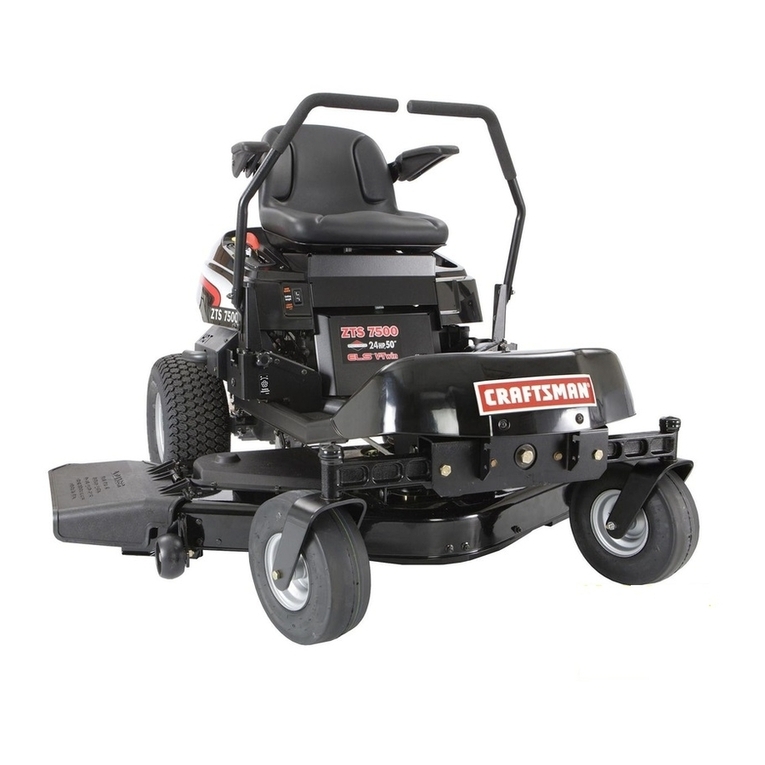
Craftsman
Craftsman ZTS 7500 Operator's manual

Toro
Toro 130-5615 installation instructions
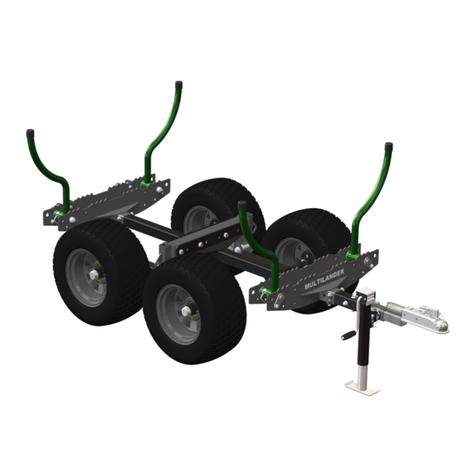
Woodland Mills
Woodland Mills MULTILANDER Operator's manual

American Sportworks
American Sportworks CW-413 Operator's manual
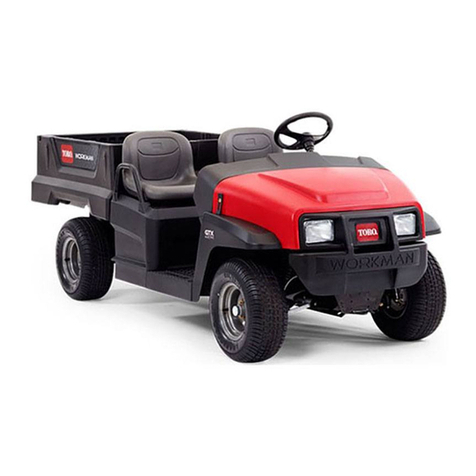
Toro
Toro WORKMAN GTX 07131 Operator's manual
